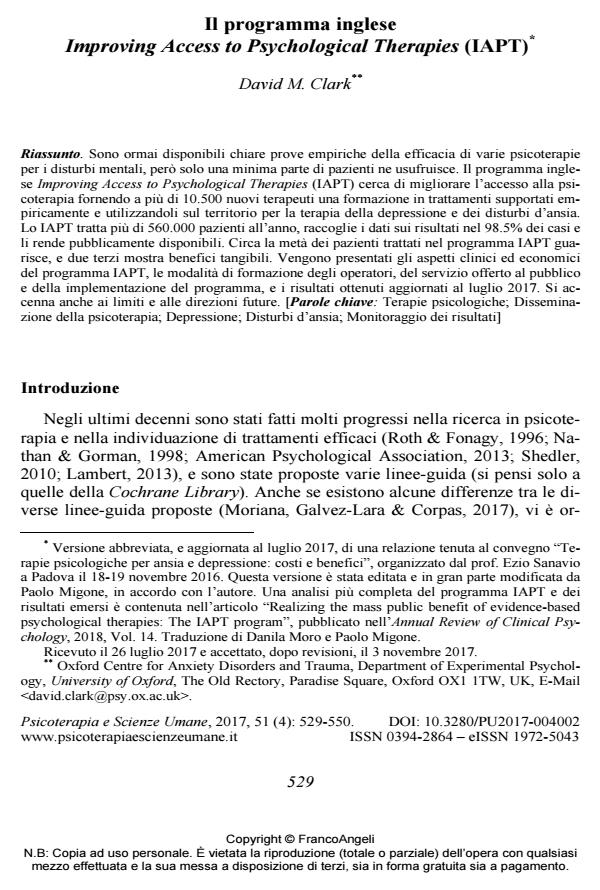The English Improving Access to Psychological Therapies (IAPT) program
Journal title PSICOTERAPIA E SCIENZE UMANE
Author/s David M. Clark
Publishing Year 2017 Issue 2017/4
Language Italian Pages 22 P. 529-550 File size 93 KB
DOI 10.3280/PU2017-004002
DOI is like a bar code for intellectual property: to have more infomation
click here
Below, you can see the article first page
If you want to buy this article in PDF format, you can do it, following the instructions to buy download credits

FrancoAngeli is member of Publishers International Linking Association, Inc (PILA), a not-for-profit association which run the CrossRef service enabling links to and from online scholarly content.
Empirical evidence shows that empirically supported treatments are helpful for many mental dis-orders. However, in most countries the great majority of people do not have access to psycho-logical therapies. The English Improving Access to Psychological Therapies (IAPT) program aims to improve the access to psychological therapies by training over 10,500 new therapists in empirically supported treatments and deploying them for the treatment of depression and anxiety disorders. IAPT treats over 560,000 patients per year, obtains clinical outcome data on 98.5% of them, and this information is in the public domain. Around half of these patients recover and about two thirds of them show benefits. The clinical and economic arguments on which IAPT is based are presented, along with details on the service model, how the program is implemented, and findings updated to July 2017. Limitations and future directions are discussed.
Keywords: Psychotherapy outcome; Dissemination of psychotherapy; Depression; Anxiety disorders; Psychotherapy outcome monitoring
- Oltre la 180. Beyond the Italian Law no. 180/1978 on psychiatric reform Ivan Cavicchi, in PSICOTERAPIA E SCIENZE UMANE 4/2022 pp.571
DOI: 10.3280/PU2022-004004 - Dalla montagna al topolino: commento a ‘Consensus conference sulle terapie psicologiche per ansia e depressione’ Silvia Paola Papini, Fabio Vanni, in Ricerca Psicoanalitica /2023
DOI: 10.4081/rp.2023.793 - Sul rinnovamento della psicoanalisi Giorgio Meneguz, in PSICOTERAPIA E SCIENZE UMANE 2/2023 pp.213
DOI: 10.3280/PU2023-002003 - Il burnout del terapeuta Margherita Spagnuolo Lobb, in QUADERNI DI GESTALT 1/2023 pp.7
DOI: 10.3280/GEST2023-001001 - Un New Deal per le terapie psicodinamiche: lo psicoanalista come burocrate di strada Jeremy Clarke, in PSICOTERAPIA E SCIENZE UMANE 2/2024 pp.199
DOI: 10.3280/PU2024-002002 - Psychodynamic therapy in the public sector in Italy: then and now. The opportunity of evidence-based practice in the birthplace of ‘care-in-the-community’ Paolo Migone, in Psychoanalytic Psychotherapy /2020 pp.147
DOI: 10.1080/02668734.2020.1825013 - Riuscire a ottenere un beneficio di massa tramite l'offerta di terapie psicologiche: l'esperienza del programma inglese. Improving Access to Psychological Therapies (IAPT) David M. Clark, in PSICOTERAPIA E SCIENZE UMANE 1/2023 pp.93
DOI: 10.3280/PU2023-001011
David M. Clark, Il programma inglese - Improving Access to Psychological Therapies (IAPT) in "PSICOTERAPIA E SCIENZE UMANE" 4/2017, pp 529-550, DOI: 10.3280/PU2017-004002